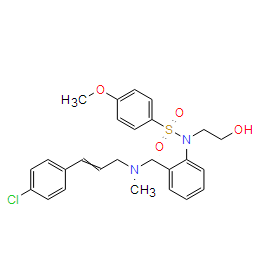| Description: |
KN-93 is a cell-permeable, reversible and competitive inhibitor calmodulin-dependent kinase type II (CaMKII) with a Ki of 370 nM. |
| Target: |
Ki: 370 nM (CaMK) |
| In Vivo: |
KN-93 (1 mg/kg/day, i.p.) inhibits retinal vascular leakage induced by diabetes, and suppresses phosphorylation of CaMKII and NF-κB in diabetic retina[4]. |
| In Vitro: |
After 2 days of KN-93 treatment, 95% of cells are arrested in G1. G1 arrest is reversible; 1 day after KN-93 release, a peak of cells had progressed into S and G2-M. KN-93 also blocks cell growth stimulated by basic fibroblast growth factor, platelet-derived growth factor-BB, epidermal growth factor, and insulin-like growth factor-1 in NIH 3T3 fibroblasts[1]. KN-93 inhibits the H+, K+-ATPase activity but strongly dissipates the proton gradient formed in the gastric membrane vesicles and reduces the volume of luminal space[2]. KN-93 (0.5 μM) prevents increased LV developed pressure during action potential prolongation and early afterdepolarizations. Ca2+-independent CaM kinase activity is increased during early afterdepolarizations and this increase is prevented by KN-93[3]. KN-93 (10 μM )significantly inhibits the activation of CaMKII/NF-κB signaling induced by elevated glucose, and subsequently decreases the expression of VEGF, iNOS and ICAM-1 in Müller cells[4]. |
| Kinase Assay: |
Cells are grown on 12-mm diameter glass coverslips in DMEM 100% serum and various concentrations of KN-93 or KN-92. After 0, 1, 2, and 3 days of culture in the presence of drug, coverslips are removed from culture, rinsed once in PBS, and then submerged in 100% methanol at -20°C for 3 min. Fixed cells are stored in PBS until staining using the TUNEL assay. Cells are overlaid on 20 μL PBS/1 mg/mL BSA for 30 min, rinsed in PBS, and then overlaid on 20 μL containing 100 mM sodium cacodylate (pH 6.8), 1 mM CoCl2, 0.1 mM DTT, 0.1 mg/mL BSA, 20 μM fluorescein-12-dUTP, and 0.1 unit/μL terminal transferase at 37°C for 60 min. Coverslips are rinsed in PBS twice, mounted on slides, and photographed using an OLYMPUS BX5O epifluorescent microscope using a UPLAN APO 40X oil immersion objective. |
| Cell Assay: |
Cell viability is assessed by the 3-(4,5-dimethylthiazol-2-yl)-2,5- diphenyltetrazolium bromide (MTT) assay. Briefly, Müller cells are seeded at a density of 10×104 cells per well in 96-well plates and cultured until sub-confluence. Next, cells are treated with curcumin for 24 h before incubation with MTT (5 mg/mL) at 37°C in 5% CO2 atmosphere for 4 h. The culture medium is then removed, and the formazan formed in the reaction is dissolved in 150 μL DMSO. The optical density of the solution is measured at 490 nm using a multifunctional microplate reader. Cell viability in each well is presented as a percentage of the control (vehicle-treated group). |
| Animal Administration: |
Male Sprague-Dawley rats (8 weeks of age) weighing 180-200 g are used in this study. Rats are housed in ventilated microisolator cages with free access to water and food. The rats are randomLy assigned to receive either 60 mg/kg STZ intraperitoneally or citrate buffer alone. Rats are categorized as diabetic when blood glucose levels exceeded 16.7 mM at 48 h after STZ treatment. Two weeks after the induction of diabetes, rats are divided randomLy into three subgroups: STZ-diabetic rats (n=12), STZ-treated diabetic rats administered curcumin (n=12), or STZ-diabetic rats administered KN93 (n=12) for a 12-week period. Curcumin is suspended in saline containing 0.5% carboxymethylcellulose at a concentration of 20 mg/mL and administered via oral gavage at a total dose of 100 mg/kg/day. KN93 is administered by intraperitoneal injection at 1 mg/kg/day. Control STZ-treated diabetic rats and non-diabetic controls (n=12) are gavage administered saline containing 0.5% carboxymethylcellulose on a daily basis. Body weights and blood glucose levels are measured every 2 weeks. At the completion of the administration protocol, animals are deeply anesthetized with pentobarbital and subsequently sacrificed. The eyes are then enucleated for investigation. |
| References: |
[1]. Tombes RM, et al. G1 cell cycle arrest and apoptosis are induced in NIH 3T3 cells by KN-93, an inhibitor of CaMK (the multifunctional Ca2+/CaM kinase). Cell Growth Differ. 1995 Sep;6(9):1063-70.
[2]. Mamiya N, et al. Inhibition of acid secretion in gastric parietal cells by the Ca2+/calmodulin-dependent protein kinase II inhibitorKN-93. Biochem Biophys Res Commun. 1993 Sep 15;195(2):608-15.
[3]. Anderson ME, et al. KN-93, an inhibitor of multifunctional Ca++/calmodulin-dependent protein kinase, decreases early afterdepolarizations in rabbit heart. J Pharmacol Exp Ther. 1998 Dec;287(3):996-1006.
[4]. Li J, et al. Curcumin Attenuates Retinal Vascular Leakage by Inhibiting Calcium/Calmodulin-Dependent Protein Kinase II Activity in Streptozotocin-Induced Diabetes. Cell Physiol Biochem. 2016;39(3):1196-208.
[5]. Park SW, et al. CRABP1 protects the heart from isoproterenol-induced acute and chronic remodeling. J Endocrinol. 2018 Mar;236(3):151-165. |






















